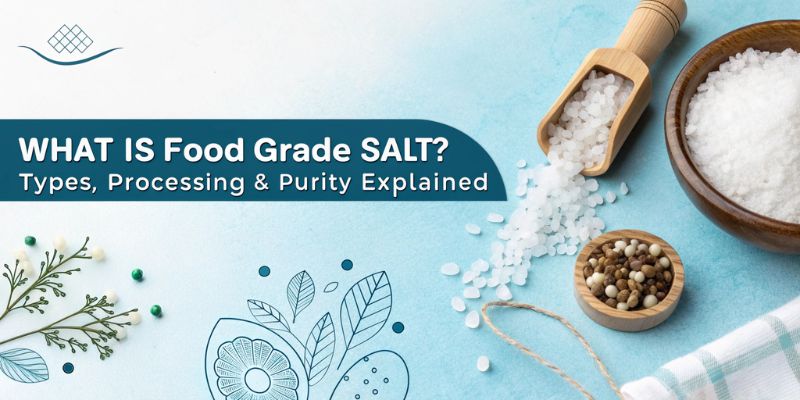
What is Food Grade Salt? Types, Processing & Purity Explained
Salt is an essential ingredient in our daily diet, used not only to enhance flavor but also to maintain proper bodily functions. Among the various types of salt available in the market, Food Grade Salt stands out due to its purity and suitability for human consumption. In this blog, we will explore what food-grade salt is, its types, the processing methods, and the purity standards that make it safe for use in households and the food industry.
What is Food Grade Salt?
Food-grade salt refers to salt that is purified and processed to meet specific quality standards for safe consumption. Unlike industrial- or technical-grade salt, food-grade salt is free from harmful impurities, heavy metals, and contaminants. This type of salt is used in cooking, food preservation, and even in certain pharmaceutical applications.
One popular variant of food-grade salt is iodized salt, which has iodine added to prevent iodine deficiency in humans—a common nutritional issue worldwide.
Types of Food Grade Salt
Food-grade salt comes in different forms depending on its processing, intended use, and additive content. Here are the most common types:
1. Refined Salt
Refined salt is the most commonly used food-grade salt in households. It is processed to remove impurities, giving it a fine texture and white appearance. Refined salt may be iodized or non-iodized depending on regional regulations.
2. Iodized Salt
Iodized salt is regular salt that has been fortified with iodine. This helps prevent thyroid-related diseases such as goiter. Iodized salt is widely recommended by health authorities and is a staple in many countries, including India.
3. Free Flow Salt
Free-flow salt is treated with anti-caking agents to prevent clumping, making it ideal for bulk storage and industrial use. It is particularly popular in packaged salt products for the food industry.
4. Sea Salt
Although not as refined as industrial salts, sea salt is considered food grade when purified for consumption. It retains natural minerals, which can add subtle flavors to dishes.
5. Rock Salt (Edible)
Rock salt is mined directly from salt deposits and then purified to make it suitable for food use. It is sometimes used in traditional cooking and culinary applications.
Processing of Food Grade Salt
The production of food-grade salt involves several steps to ensure purity, safety, and quality. Here’s an overview of the typical process:
1. Extraction
Salt is obtained either from seawater through evaporation or from underground salt mines.
2. Purification
The raw salt is washed and filtered to remove insoluble impurities such as clay, sand, and silt.
3. Crushing and Grinding
The purified salt is then crushed or ground into the desired particle size, suitable for cooking or industrial use.
4. Iodization (Optional)
For iodized salt, iodine compounds are added to the salt during this stage to fortify it.
5. Drying
The salt is dried to reduce moisture content, preventing caking and ensuring a long shelf life.
6. Packaging
Finally, food-grade salt is packed in moisture-proof, hygienic packaging to maintain quality during transportation and storage.
Purity Standards for Food Grade Salt
Purity is a critical aspect of food-grade salt, as contaminants can be harmful to human health. Regulatory authorities set strict standards for food-grade salt to ensure it is safe for consumption.
Key Purity Standards Include:
- Sodium Chloride Content: Food-grade salt must contain at least 97-99% pure sodium chloride (NaCl).
- Moisture Content: Typically less than 1% to prevent clumping and microbial growth.
- Heavy Metals: Levels of heavy metals such as lead, arsenic, and mercury must be below safe limits.
- Iodine Content: For iodized salt, iodine should be present in specified concentrations to meet nutritional requirements.
- Anti-Caking Agents: Only approved additives may be used to maintain free-flow properties.
Adhering to these standards ensures that food-grade salt remains safe, healthy, and effective in both household and industrial applications.
Health Benefits of Food-Grade and Iodized Salt
- Prevents Iodine Deficiency: Iodized salt supports thyroid function and prevents goiter.
- Maintains Electrolyte Balance: Sodium is vital for nerve and muscle function.
- Enhances Food Flavor: Food-grade salt enhances the taste of meals without introducing harmful impurities.
- Supports Industrial Food Production: Free-flow salt and high-purity food-grade salt are essential for processed foods, sauces, and packaged goods.
Choosing the Right Food Grade Salt
When selecting food-grade salt, consider the following:
- Purity: Ensure it meets national and international purity standards.
- Iodization: Opt for iodized salt for nutritional benefits.
- Texture: Choose coarse, fine, or free-flowing salt based on cooking requirements.
- Source: Prefer reputable brands and certified manufacturers.
By choosing high-quality food-grade salt and iodized salt, consumers can enjoy safe, nutritious, and flavorful meals.
Conclusion
Food-grade salt is more than just a cooking ingredient—it is a vital component of a healthy diet. Understanding its types, processing methods, and purity standards helps ensure that you consume salt safely and effectively. Whether you are using iodized salt at home or sourcing food-grade salt for industrial purposes, prioritizing quality is essential for health and safety. By following these guidelines, you can make informed choices and enjoy the numerous benefits of high-quality food-grade salt.